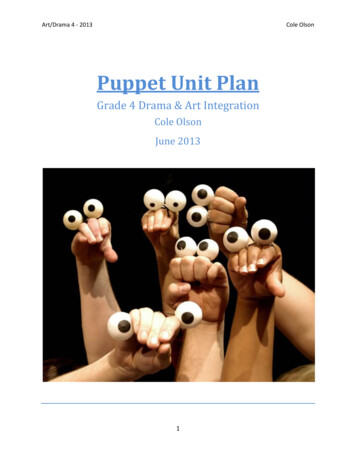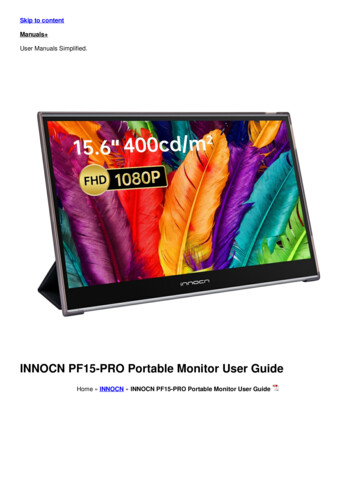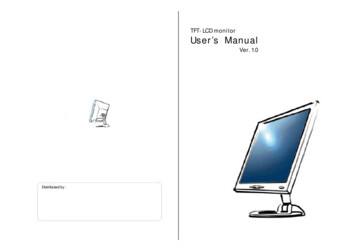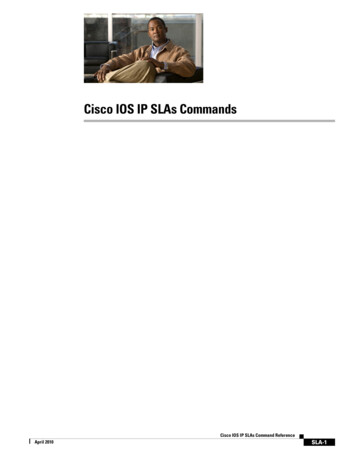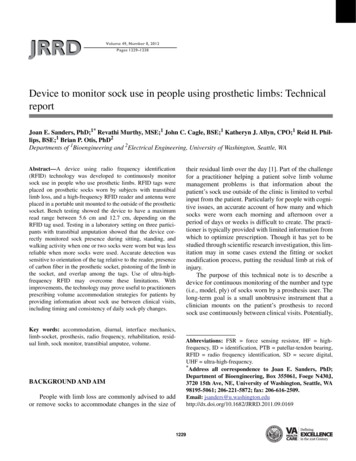
Transcription
JRRDVolume 49, Number 8, 2012Pages 1229–1238Device to monitor sock use in people using prosthetic limbs: TechnicalreportJoan E. Sanders, PhD;1* Revathi Murthy, MSE;1 John C. Cagle, BSE;1 Katheryn J. Allyn, CPO;1 Reid H. Phillips, BSE;1 Brian P. Otis, PhD2Departments of 1Bioengineering and 2Electrical Engineering, University of Washington, Seattle, WAtheir residual limb over the day [1]. Part of the challengefor a practitioner helping a patient solve limb volumemanagement problems is that information about thepatient’s sock use outside of the clinic is limited to verbalinput from the patient. Particularly for people with cognitive issues, an accurate account of how many and whichsocks were worn each morning and afternoon over aperiod of days or weeks is difficult to create. The practitioner is typically provided with limited information fromwhich to optimize prescription. Though it has yet to bestudied through scientific research investigation, this limitation may in some cases extend the fitting or socketmodification process, putting the residual limb at risk ofinjury.The purpose of this technical note is to describe adevice for continuous monitoring of the number and type(i.e., model, ply) of socks worn by a prosthesis user. Thelong-term goal is a small unobtrusive instrument that aclinician mounts on the patient’s prosthesis to recordsock use continuously between clinical visits. Potentially,Abstract—A device using radio frequency identification(RFID) technology was developed to continuously monitorsock use in people who use prosthetic limbs. RFID tags wereplaced on prosthetic socks worn by subjects with transtibiallimb loss, and a high-frequency RFID reader and antenna wereplaced in a portable unit mounted to the outside of the prostheticsocket. Bench testing showed the device to have a maximumread range between 5.6 cm and 12.7 cm, depending on theRFID tag used. Testing in a laboratory setting on three participants with transtibial amputation showed that the device correctly monitored sock presence during sitting, standing, andwalking activity when one or two socks were worn but was lessreliable when more socks were used. Accurate detection wassensitive to orientation of the tag relative to the reader, presenceof carbon fiber in the prosthetic socket, pistoning of the limb inthe socket, and overlap among the tags. Use of ultra-highfrequency RFID may overcome these limitations. Withimprovements, the technology may prove useful to practitionersprescribing volume accommodation strategies for patients byproviding information about sock use between clinical visits,including timing and consistency of daily sock-ply changes.Key words: accommodation, diurnal, interface mechanics,limb-socket, prosthesis, radio frequency, rehabilitation, residual limb, sock monitor, transtibial amputee, volume.BACKGROUND AND AIMPeople with limb loss are commonly advised to addor remove socks to accommodate changes in the size ofAbbreviations: FSR force sensing resistor, HF highfrequency, ID identification, PTB patellar-tendon bearing,RFID radio frequency identification, SD secure digital,UHF ultra-high-frequency.*Address all correspondence to Joan E. Sanders, PhD;Department of Bioengineering, Box 355061, Foege N430J,3720 15th Ave, NE, University of Washington, Seattle, WA98195-5061; 206-221-5872; fax: 206-616-2509.Email: /JRRD.2011.09.01691229
1230JRRD, Volume 49, Number 8, 2012the instrument could be extended to instruct a patientwhen socks need to be added. After a recording period,the practitioner downloads collected data to view arecord of daily sock use, when sock changes were made,and how consistently the patient performed accommodation. This information may help the practitioner enhanceprescription [2]; it is new information not currently available. A practitioner may gain insight into differencesbetween a patient’s weekday and weekend volumechanges, for example. In this technical note, we describethe design of a prototype instrument to monitor sockpresence, results from subject testing, and recommendations for further development.METHODS AND RESULTSDevice DesignThe sock monitor uses radio frequency identification(RFID) technology to detect sock presence. Passive RFIDtags ( 0.1 mm thick) are taped to the user’s prostheticsocks (one tag per sock), and a tag reader is mounted onthe external socket surface (Figure 1). The reader, via itsantenna, communicates wirelessly to the tags to determinewhich tags are present. Because it is desirable to detectonly socks inside the socket, high-frequency (HF) radiocommunication (13.56 MHz) is used [3].HF RFID has a relatively short detection range (lessthan 14 cm), consistent with the needs of the presentapplication, with the detection distance dependent uponsurrounding materials as well as reader and tag designfeatures. When a tag is within the magnetic field generated by the reader’s coil such that the power delivered tothe tag is sufficiently high, the tag communicates back tothe reader via radio frequency backscattering. The communication is controlled by an integrated circuit on thetag that modulates the tag impedance between two states:matched and unmatched [4]. By recording the reflectedradio frequency energy, the reader can “feel” the state ofthe tag impedance, thus allowing transmission of information from the tag to the reader. The tag’s integratedcircuit thus generates a byte stream to the reader. Foreach tag, the integrated circuit can be programmed togenerate a unique pattern of high and low impedances (aunique byte stream), allowing tags on different socks tobe distinguished from each other [4]. The reader thendemodulates the backscattered signals and transmits thedata to a data storage medium.Figure 1.Sock monitor on socket. Prototype was mounted on anterior lateral surface with Velcro straps. Reader antenna (dashed line)was contained within box in this prototype.We used a modular HF RFID reader (M4, SkyeTek;Denver, Colorado) with a microcontroller (MSP430F1611,Texas Instruments; Dallas, Texas), oscillator, secure digital(SD) card (31198–2GBCSTA, Kodak; Rochester, NewYork), card connector (Olimex; Plovdiv, Bulgaria), 9 V battery, and antenna to create a device that continuously monitored sock presence and stored data to the card (Figure 2).Upon depressing a power switch, the microcontrollerrepeatedly executed a simple collect-and-store sequence.Seven times each 2 s, the microcontroller sent a commandto the RFID module requesting an inventory of tags in the
1231SANDERS et al. RFID to monitor sock use in people with prosthetic limbsTable.Radio frequency identification tags used for unobstructed detectiondistance tests.Tag ID123Figure 2.System layout. Components were housed within box mountedto external socket surface. SD secure digital.range of the antenna. A tag, with its own unique identification (ID) number (byte stream) and of surface area approximately that of a dime, was attached to each sock tested. Thetags were flexible, similar to those currently used in the garment industry for inventory tracking. The RFID moduleresponded with the tag ID numbers from the tag inventory(any tag recognized during the seven sequences wasrecorded once), and the list was stored to the microcontroller. Before the microcontroller sent another inventorycommand, it saved the tag inventory byte stream to a textfile on the SD card. With this strategy, data on the SD cardwas constantly updated, thus ensuring no data were lost ifthe system was turned off. Using a 9 V/1,200 mAh battery,this system was capable of operating continuously forapproximately 10 h.Bench TestingWe performed bench tests to evaluate the distanceover which the reader detected tags as well as sensitivityto tag/reader orientation and materials near the unit.Unobstructed Detection DistanceWe tested five different tag sizes to determine thedistance range over which tags could be detected. Four ofthe tags were rectangular and one was circular (Table).Tags were acquired from Avery Dennison (Pasadena,California) and Texas Instruments (Dallas, Texas). Alltags used coil antenna geometries.We placed the sock monitor on a laboratory table andpositioned a wooden ruler vertically adjacent to thereader antenna. We held a test tag parallel and centered tothe face of the reader antenna several millimeters aboveits surface until communication was established betweenthe tag and the reader. Then, we slowly moved the tagaway from the reader (15 mm/10 s) until the nnaDimensionsLength Width(cm)7.1 4.04.0 4.03.5 3.5CircleRectangle3.3 (diameter)2.8 1.0ShapeAD Avery Dennison (Pasadena, California), TI Texas Instruments (Dallas,Texas).was lost. We made several slow up/down oscillations ofapproximately 1 mm amplitude such that the tag was incommunication at the trough and out of communicationat the peak. We noted the trough as the maximum readdistance for that tag. We tested three tags of each typeand recorded the mean maximum read distance.Results showed that read distance increased with surface area (Figure 3) and ranged from 5.6 cm for thesmallest tag (#5) to 12.7 cm for the largest tag (#1). Tagdetection was independent of sock material or sock thickness for thickness up to at least 1 cm.Detection in Presence of Socket Materials and HumanTissueWe tested the effect on performance of different materials in the reader/tag environment by creating a testmodel. The materials tested were intended to reflect thosethe sock monitor would be exposed to in clinical use. Wefilled a plastic bag with a mixture of salt and water so thatit had an equivalent conductivity to human muscle tissue[5]. The bag of saltwater was inserted into a prostheticelastomeric liner, the liner was covered with a 3-ply cottonsock, and then the assembly was inserted into a prostheticsocket. Two sockets were tested: a PETG (glycol-modifiedpolyethylene terephthalate) socket and a composite socketthat included three layers of carbon fiber. We tested thesesockets to determine whether performance was dependenton socket material. These socket materials were selectedbecause they presented low and high obstructive properties for RFID transmission. A different reader antenna,made of copper traces printed on a flexible substrate(antenna surface area 24.0 cm2), was used instead of thestiff-backed antenna included with the SkyeTek kit
1232JRRD, Volume 49, Number 8, 2012Figure 3.Unobstructed read distance results. Maximum read distance forfive tags tested was approximately proportional to surface areaof tag’s antenna.because the antenna needed to be flexible to fit on theinside surface of a prosthetic socket.Four small tags (#5 in Table) in a 2 2 matrix wereused as a test article. We chose small tags because they fitwithin the area of the reader’s antenna without overlap,and we used four tags because that was the maximumnumber possible within this space. The test article wasinserted into the test socket between the sock and liner. Ina static reliability test, we positioned the antenna outsideof the socket (at about three-fourths of its detectionrange) with the test article centered and monitored for a30 s interval. In a dynamic detection test, we slowlymoved the antenna in an area sweep about the face of thetag to determine whether the maximum read count (number of socks detected) was the same as in the static reliability tests.We found for all tests that if all four tags weredetected in a given test setup, the first detection of alltags occurred within the first 9 s of sampling. Duringstatic reliability testing, all four tags were detected usingthe polymer socket but only two were detected using thecarbon fiber socket, likely because of detuning of theRFID antennae from the presence of the carbon fiber.We created additional test configurations to assessmaterial presence behind and in front of as opposed tobetween the reader antenna and RFID tag. First, weplaced the antenna on a loose sheet of carbon fiber weave(0.3 mm thickness), and then we placed the test article onthe antenna. In the second configuration, we placed thetest article between a sock and liner that had been cut atthe distal end so as to fit over the proximal aspect of thelower leg (over the gastrocnemius area) of a nondisabledperson. The flexible reader antenna was placed over theoutside of the liner. We tested with and without the carbon fiber weave over the antenna. A third configurationwas identical to the second except that bony human tissue(the anterior medial tibial area of the proximal lower legof a nondisabled person) was used.Results were very sensitive to slight position changesof the test materials relative to the antenna, a findingexpected to reflect inhomogeneities in the test materials.Quantitative test results demonstrated too much scatter inthe data to be statistically meaningful. Qualitatively, weobserved that the three materials had a moderate to stronginfluence toward decreasing the number of tags detected.In order of greatest to least influence these three materials were carbon fiber, fleshy human tissue (gastrocnemius), and bony human tissue (tibia).Preliminary Studies on Participants with TranstibialAmputationSubjectsWe collected data on three participants with unilateral transtibial amputation. Subjects were included in thestudy if they had a transtibial limb amputation more than18 mo prior, they were K-2 (Medicare Functional Classification Level [6]) or higher level ambulators, and theirsocket fit as deemed by the research prosthetist wasacceptable for regular use. Subjects were excluded if theyhad current skin breakdown.Subject #1 was a 52 yr old male who had a righttranstibial amputation 2 yr prior because of osteomyelitis.He had pitting edema in his contralateral limb at level 3 on a scale of 0 to 3 . He used a patellar-tendon bearing(PTB) endoskeletal prosthesis; a composite socket withone layer of Dacron, two layers of Kevlar, and four layersof nylon; a 3 mm Ossur Iceross Comfort liner; and aSeattle LightFoot. He claimed to use one 3-ply and one5-ply wool sock every day, all day with no changes. Theresearch practitioner suspected that he did not changesocks because of his poor sensation. His prosthesis wassuspended by a distal lock and pin attachment, but thesocket may have been loose fitting around the proximalsection because socks were not added to take up volume
1233SANDERS et al. RFID to monitor sock use in people with prosthetic limbsloss over the day. Because of the long, large shape of hisresidual limb, the high surface area may have helpedaccommodate for the lack of sock-ply.Subject #2 was a 63 yr old male with transtibialamputation from a traumatic accident 8 yr prior. He had aconical residual limb. He was very aware of his prostheticfit and knew when he should add a sock for better fit. Heused a PTB endoskeletal prosthesis, a polypropylenesocket, a 6 mm Alpha liner, lock and pin suspension, anda Luxon Max dynamic response prosthetic foot. His residual limb volume fluctuated during the day very little, andhe added a 1-ply cotton sock only during extreme activity.Subject #3 was a 48 yr old female with right transtibial amputation due to multiple burn injuries from a housefire more than 10 yr prior. She had a very short conicalresidual limb with scar tissue from traumatic burns.There were signs of too much distal end contact with firmcallous and pressure marks on the distal end of the tibia,distal patella, and medial condyle. She was delivered aPTB-endoskeletal prosthesis 15 mo prior, with a 3 mmOssur Iceross Comfort liner with lock and pin suspensionand Seattle Carbon Lightfoot. Her composite socket wasmade of one layer of Dacron, six layers of Nyglass stockinette, two layers of carbon fiber weave, and two layersof nylon stockinette. In this prosthesis, her volume fluctuated throughout the day, but never more than a 1-plysock at a time.ProtocolThe tags were placed on the insides of the socksusing paper tape, and subjects donned the socks such thatthe RFID tags were over the anterior lateral distal regionof the residual limb. We found that this location producedthe most reliable measurements, in part because this areawas relatively flat and the box housing the reader andantenna was mechanically stable at this location and didnot interfere with gait. Subjects used blend or wool socksof 1-, 2-, or 3-ply. When socks were added, as indicatedby the protocol described in this section, the researchpractitioner selected sock ply based on what was comfortable for the subject.We conducted two different test protocols: (1) Fittingtest: Data were collected during donning, sitting, standing, and doffing. We performed tests sequentially withthe subject donning an additional RFID-tagged sock onthe residual limb for each successive test. Tests were conducted until the subject deemed the number of socks tocause an uncomfortable fit or the research prosthetist feltthat additional socks put the subject’s limb at risk ofinjury. (2) Activity test: Wearing the number of socksdeemed comfortable and appropriate, data were collectedcontinuously during donning, standing, walking, stairclimbing, lateral shifting, and doffing. Subject #2 conducted additional tests on different walking surfaces—grass, gravel, and an inclined surface.While data collection on Subjects #1 and #2 was successful, Subject #3’s socket inhibited communicationbetween the reader and tags. This subject’s socket, unlikethose of Subjects #1 and #2, had several carbon fiber layers embedded within its lamination. We tested additionalsockets available in the laboratory from prior researchprojects and found that some sockets limited reader/tagcommunication and others did not. In general, the greaterthe number of carbon fiber layers, the greater the interference to reader/tag communication.ResultsFor Subjects #1 and #2, for both the fitting tests andthe activity tests, we found it necessary at the outset ofthe test session to carefully adjust the position and orientation of the box holding the reader and antenna so as toachieve effective reader/tag communication. There was anarrow range of approximately 0.5 cm from the centerof the tags within which reader/tag communication wasachieved. Once proper position and orientation wereestablished, however, no adjustment was needed for therest of the test session if three or fewer tags were worn.Results from the fitting tests for Subjects #1 and #2demonstrated that the system recognized socks wellwhen one or two socks were worn, moderately well whenthree socks were worn, and poorly when four socks wereworn (Figure 4(a) and (b)). We found that with three ormore socks, the system identified only some of the socksat times and then at other times identified all of the socks.When Subject #1 wore four socks, despite numerousattempts at adjusting the socks to avoid overlappingRFID tags with each other, we were not able to reliablydetect more than three socks (Figure 4(b)). These resultssuggest that when tags were adjacent to one another, a“collision” problem occurred. In RFID terminology, collision means that tags interfere such that some tags maskdetection of other tags.Over the course of a 7 min activity session for Subject #1, the system performed well in that it provided acontinuous uninterrupted output signal. It correctly recognized that the subject wore three socks, albeit with a
1234JRRD, Volume 49, Number 8, 2012Figure 4.Fitting test results. (a) Subject #2: During each of four testing intervals, subject wore number of socks indicated (1, 2, 3, or 4).(b) Subject #1 wearing four socks. Seven attempts were made, making adjustments to antenna or tag positions, to detect all foursocks but none was successful. System was turned off between tests while subject doffed socket; thus, time axes represent cumulative time during which data were collected.few errors (Figure 5(a)). Intermittent errors occurredwhen limb-socket displacement (pistoning) was likelyelevated—right after donning, walking down stairs, andas the prosthesis was prepared for doffing. The intermittent errors were expected to be the result of several factors—the tag moved too far away from the readerantenna to be powered, there were collision problems,processing filters embedded within the M4 reader module were inappropriate for our application, and excessiveangulation of the plane of the tag antenna relative to thatof the reader antenna was present. When Subject #1 worefour socks, detection deteriorated (Figure 5(b)). Typically, the reader detected only three of the four socks.The sock monitor performed better during activitytests on Subject #2 than on Subject #1. During donning,standing, walking, stair-climbing, lateral shifting, anddoffing over a 1 hr period, the system consistentlydetected all three socks (Figure 6). In addition, walkingon other surfaces, including grass, gravel, and an inclinedsurface, did not distort performance.DISCUSSIONA sock monitor may prove useful for prosthetic fitting by providing quantitative information to the practi-tioner between clinical visits about how many socks apatient wears and when sock changes are made. Potentially, the technology could be used with a feedback system (alarm, message to smartphone) to alert patientswhen they need to add a sock. The efforts described heredemonstrate that a sock monitor based on RFID technology is possible, but there are challenges that need to beovercome for it to operate as a reliable clinical device.We present here explanations of the challenges andpotential solutions.Socket MaterialCarbon fiber is a semiconductive material, having aconductivity of about 1/900th that of copper, though theexact value depends on the number of carbon fibers perbraid and other factors [5]. Carbon fiber-mesh layerswithin the socket prevented reader/tag communicationbecause the carbon fiber altered the resonant frequency ofthe reader antenna away from 13.56 MHz and/or interrupted its magnetic field so that the tags were not powered.Such interference from surrounding materials is a recognized problem in RFID technology [3]. To solve this problem, the engineer typically modifies the reader antenna sothat it tunes to 13.56 MHz with the interfering materialpresent and/or enhances the magnetic field strength, forexample by adding more windings to the reader’s coil. An
1235SANDERS et al. RFID to monitor sock use in people with prosthetic limbsFigure 5.Activity test results: Subject #1. Subject wore (a) three socks and (b) four socks. Reader detected all socks well when three sockswere worn (a), but failed to detect all socks when four socks were worn (b).Figure 6.Activity test results: Subject #2. Subject wore three socks during entire test while he walked on different surfaces, stood,climbed stairs, or sat. Reader detected sock presence well forall activities.alternative strategy that avoids the need to transmitthrough the carbon fiber material altogether is to place thereader antenna on the inside socket surface, within a flexcircuit, for example, or within the wall of the socket. However, even though the carbon fiber is not between thereader and tag, it can still cause detection problems, asdemonstrated in our bench tests. The reader antenna mustbe carefully designed to prevent interference.Angle of Tag Relative to Reader AntennaWith HF RFID, the reader powers the tag via themagnetic field generated by its antenna coil. It will powerthe tag only when the plane of the tag’s antenna coil isparallel with that of the reader’s. Ultra-high-frequency(UHF) RFID overcomes this problem by generating electromagnetic fields instead of magnetic fields. In electromagnetic fields, electrical and magnetic fields orthogonalto each other are generated via a feed point on theantenna, generating fields in multiple directions [4]. Thesingle direction limitation of HF RFID is avoided.Because of this capability, with UHF the tags do not havethe restriction of being positioned in parallel planes withthe reader antenna, and thus may be more effective atovercoming tag antenna to reader antenna orientationproblems for the present application.CollisionRFID readers may have difficulty detecting overlapping tags because one tag may shield power to other tagsor distort radio frequency backscatter from other tags tothe reader. In recent years, anticollision algorithms havebeen generated for UHF RFID systems that help overcome this problem [7]. The Gen2 tag used with UHF is, inpart, a result of these efforts. Tag size, shape, and positioncould also be adjusted to overcome collision problems.Large Displacements (Pistoning)Subject #1’s excessive pistoning compared with Subject #2’s was likely the primary reason why sock detection
1236JRRD, Volume 49, Number 8, 2012was less effective for Subject #1 than Subject #2. For HFRFID, when the tag moves outside of the closed contourformed by the coil generating the magnetic field, the tagwill not be powered and thus will not be detected. Thisproblem can be overcome by enlarging the size of theantenna or using more antennae. However, these modifications will come at the expense of increased power consumption. UHF overcomes this problem because UHFmagnetic fields, as described in the previous section, arenot limited to a single direction. Also, the reader powersthe tags via both electric field coupling (at greater distances) as well as magnetic field coupling. The distancerange over which UHF detects tags is greater than HF,making it possible that tags on socks outside of the socket,for example on a table near the prosthesis, are detected.Thus if UHF is implemented, efforts may need to be takento eliminate detection of such tags or recognize that theprosthesis is not being worn so as to avoid confusion inclinical interpretation of the data.PowerTo extend from the design described here that operates for 10 h of continuous use to a longer-term monitoring tool (e.g., months), a power management strategywill need to be implemented. Adding a thin in-socketpressure sensor (e.g., force sensing resistor (FSR), capacitive sensor, or optical pressure sensor) to the inside surface of the posterior socket wall, for example, to identifywhen the socket is doffed and feeding the signal into themicrocontroller would allow power to be turned off whenthe prosthesis was not worn. Pressure sensors can now beembedded within flex circuits; thus, they can be positioned nonobtrusively inside the socket against the posterior socket wall. This technology has been used forsocket pressure monitoring in research investigations [8].Since only sock changes need to be monitored to characterize a patient’s sock use, not continuous sock presenceas performed in this study, the system could be turned offexcept when in-socket pressures indicated a change froma doffed to donned state occurs. In addition, FSR datacoupled with sock monitor information may provide thepractitioner with insight into how sock use relates topatient activities (e.g., standing, walking, sitting), environment (e.g., uphill climbing), and health (e.g., balance), more information than just sock presence alone.Such information could provide additional insight usefulto prescription.Once the challenges described here are overcome, akey step is to collect data on people wearing prostheticlimbs to determine whether and how sock use data arerelevant to patient care. Answering the following questions may provide insight: How often do people add asock? How regular are their sock-addition practices?How do results relate to patient comfort and satisfactionwith the prosthesis? How much do decisions to changesock ply relate to a person’s subsequent activity? Asactive RFID tags become available, tags that have sensing elements within them (e.g., temperature, sweating,displacement, or force sensors) may allow additionalinformation to be collected and provided to the practitioner and patient. Potentially, feedback systems can bedeveloped to alert patients when they need to add a sock.Other applications, for example monitoring sock use indiabetic foot patients, may also provide clinically usefulinsight to enhance patient care and quality of life.CONCLUSIONSRFID technology can be effectively used to monitorsock presence in people using prosthetic limbs. While HFRFID detected sock presence, UHF RFID may be moreeffective for this application so as to overcome problemswith collision, tag orientation, pistoning, and interference. Once a small portable device is created, clinicalinvestigations need to be conducted to determine whetherand how sock use data help the practitioner diagnose thepatient’s status and needs and create an effective prosthesis prescription. Potentially, the sock monitor can beextended into a clinical feedback device to tell a patientvia alarm, smartphone message, or some other meanswhen a sock needs to be added or removed.ACKNOWLEDGMENTSAuthor Contributions:Study concept and design: J. E. Sanders, B. P. Otis.Acquisition of data: R. Murthy, J. C. Cagle, R. H. Phillips.Analysis and interpretation of data: J. E. Sanders, J. C. Cagle,K. J. Allyn, R. H. Phillips.Drafting of manuscript: J. E. Sanders, J. C. Cagle.Critical revision of manuscript for important intellectual content:R. H. Phillips, R. Murthy, K. J. Allyn, B. P. Otis.Obtained funding: J. E. Sanders.Study supervision: J. E. Sanders, J. C. Cagle, B. P. Otis.
1237SANDERS et al. RFID to monitor sock use in people with prosthetic limbsFinancial Disclosures: The authors have declared that no competinginterests exist.Funding/Support: This material was based on work supported by theNational Institutes of Health (grant HD069387–01).Additional Contributions: We appreciate input from Pavel Nitkin,PhD, from Intermec (Everett, Washington) concerning RFIDtechnology.Institutional Review: All procedures were approved b
1229 JRRD Volume 49, Number 8, 2012 Pages 1229-1238 Device to monitor sock use in people using prosthetic limbs: Technical report Joan E. Sanders, PhD;1* Revathi Murthy, MSE;1 John C. Cagle, BSE;1 Katheryn J. Allyn, CPO;1 Reid H. Phil- lips, BSE;1 Brian P. Otis, PhD2 Departments of 1Bioengineering and 2Electrical Engineering, University of Washington, Seattle, WA

